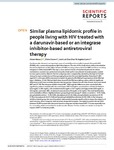Mostrar o rexistro simple do ítem
Similar plasma lipidomic profile in people living with HIV treated with a darunavir-based or an integrase inhibitor-based antiretroviral therapy
| dc.contributor.author | Mena, Álvaro | |
| dc.contributor.author | Clavero, Elvira | |
| dc.contributor.author | Díaz-Díaz, José Luis | |
| dc.contributor.author | Castro-Iglesias, Ángeles | |
| dc.date.accessioned | 2021-09-29T09:42:41Z | |
| dc.date.available | 2021-09-29T09:42:41Z | |
| dc.date.issued | 2019-11-20 | |
| dc.identifier.citation | Mena Á, Clavero E, Díaz-Díaz JL, Castro Á. Similar plasma lipidomic profile in people living with HIV treated with a darunavir-based or an integrase inhibitor-based antiretroviral therapy. Sci Rep. 2019;9(1):17182 | es_ES |
| dc.identifier.issn | 2045-2322 | |
| dc.identifier.uri | http://hdl.handle.net/2183/28529 | |
| dc.description.abstract | [Abstract] Cardiovascular disease is an important cause of morbidity and mortality in people living with HIV (PLWH), who commonly experience lipid disturbances. The aim of this study was to determine whether the plasma lipidomic profile differs between PLWH receiving a darunavir-based ART and those receiving integrase inhibitor-based ART. This was a cross-sectional study of unselected patients for whom metabolomic analysis was performed using ultra-high-performance liquid chromatography coupled to mass spectrometry. Data for the two subgroups were compared by calculating the log2 of the fold change for each metabolite and then grouping these into the main lipid families. Sixty-two PLWH aged 49.3 ± 8.6 years (82% men) were included: 12 patients (19.4%) had hypertension, 8 (12.9%) had type 2 diabetes, 25 (41.0%) had dyslipidaemia and 9 (14.5%) were taking statins, without significant differences in all these variables between the two groups. Twenty-five (40.3%) received darunavir-based ART and 37 (59.7%) integrase inhibitor-based ART. Although the differences were not statistically significant, patients treated with darunavir-based ART had higher concentrations of total cholesterol (211 mg/dL vs 194 mg/dL), LDL-cholesterol (132 mg/dL vs 117 mg/dL) and triglycerides (155 mg/dL vs 122 mg/dL), and lower HDL-cholesterol concentration (50 mg/dL vs 52 mg/dL). The main lipid families and metabolites differed slightly between groups (log2-fold change; P-value): ceramides (−0.07; 0.49), phosphatidylinositols (−0.05; 0.63), diacylglycerols (0.10; 0.64), phosphatidylethanolamines (0.03; 0.78), triacylglycerols (0.27; 0.18) and lysophosphatidylethanolamines (0.03; 0.83). In the integrase inhibitor-based group, the use of tenofovir alafenamide fumarate significantly increases the majority of lipid fractions, when compared with tenofovir disoproxil fumarate. The lipidomic profile did not differ between PLWH treated with darunavir-based or integrase inhibitor-based ART. This was especially true for ceramides, which are involved in cardiovascular disease. Further studies are needed to study the impact of ART in lipidomic profile. | es_ES |
| dc.language.iso | eng | es_ES |
| dc.publisher | Nature | es_ES |
| dc.relation.uri | https://doi.org/10.1038/s41598-019-53761-7 | es_ES |
| dc.rights | Atribución 3.0 España | es_ES |
| dc.rights.uri | http://creativecommons.org/licenses/by/3.0/es/ | * |
| dc.subject | Prognostic makers | es_ES |
| dc.subject | Dyslipidaemias | es_ES |
| dc.title | Similar plasma lipidomic profile in people living with HIV treated with a darunavir-based or an integrase inhibitor-based antiretroviral therapy | es_ES |
| dc.type | info:eu-repo/semantics/article | es_ES |
| dc.rights.access | info:eu-repo/semantics/openAccess | es_ES |
| UDC.journalTitle | Scientific Reports | es_ES |
| UDC.volume | 9 | es_ES |
| UDC.issue | 1 | es_ES |
| UDC.startPage | 17182 | es_ES |
Ficheiros no ítem
Este ítem aparece na(s) seguinte(s) colección(s)
-
INIBIC-VC - Artigos [37]







